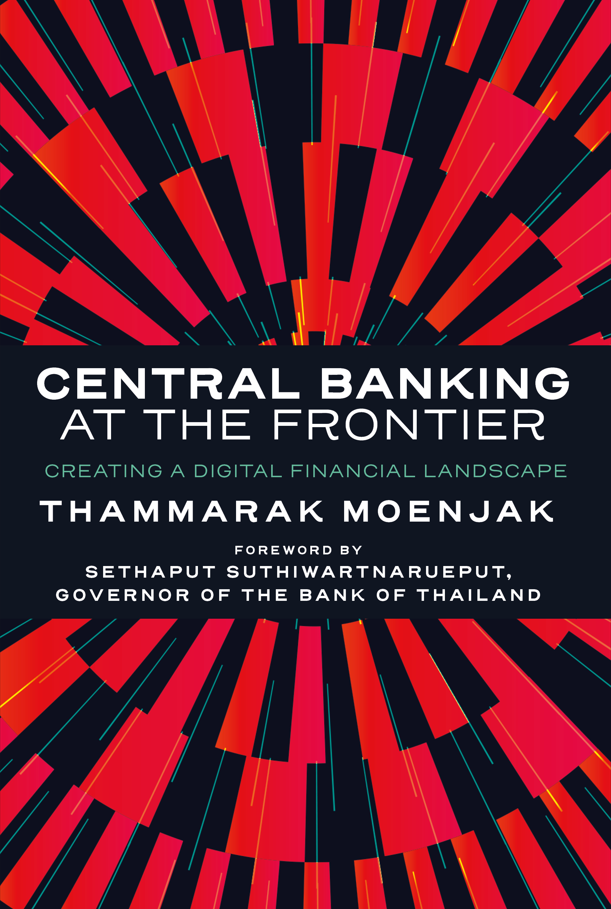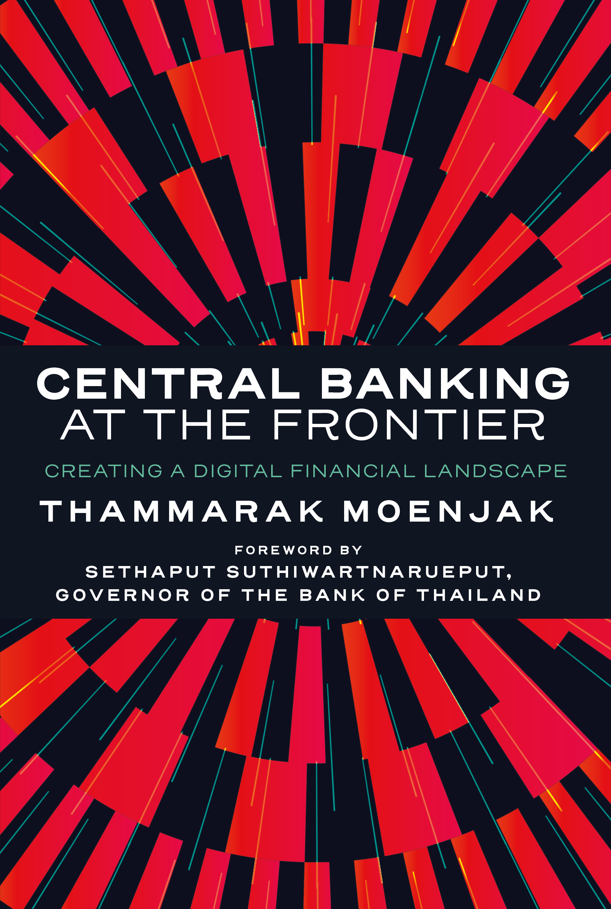
A Website accompanying the book
Central Banking at the Frontier
Creating a Digital Financial Landscape




THAMMARAK MOENJAK
Central Banking at the Frontier:
Creating a Digital Financial Landscape
About this website
This is an accompanying website for the book “Central Banking at the Frontier: Creating a Digital Financial Landscape” by Thammarak Moenjak. The hardcover will be launched in September 2024 by Emerald Publishing, United Kingdom. This website contains related information including praises by distinguished economists, scholars, researchers, policy makers, and practitioners in the financial sector as well as posts by the author. Continue to read the sections that follow to know better about the contents of the book, views of those who have read the manuscript, and current issues in digital financial landscape and the roles and responsibilities of central banks.

Why This book?
Digital disruption is happening right now

The Dawn of the Digital Financial Landscape
01
New technologies
The combination of smartphones, cloud computing, biometrics, application programming interface (API), artificial intelligence (AI), and distributed ledger technology (DLT) is changing how customers access financial services, bringing in new players with new business models.
02
New players
Cloud based and AI enabled, agile players such as FinTech, Virtual Banks, BigTech, are now competing directly with digitally transformed incumbents. Branch networks are no longer a barrier to entry. Financial products are available 24/7, digitalized, customized, and more inclusive.
03
New business models
Embedded finance, virtual banking, BigTech super apps, bank super apps, and decentralized finance (DeFi) are changing competition dynamics in the emerging digital financial landscape. Different types of players are competing and collaborating to provide financial services wherever and whenever the consumers might need them.
What does digital disruption mean for central banks?
How monetary and financial stability could be threatened by digital disruption?
Digital disruption is bringing about eight key challenges that could pose direct and indirect threats to monetary and financial stability, the two key mandates of most central banks.
The eight challenges include: (1) walled gardens, (2) shadow banking, (3) monetary sovereignty, (4) singleness of money, (5) customers’ data rights, (6) AI ethics, (7) cybersecurity, and (8) financial exclusion.
Walled gardens (e.g. closed loop financial ecosystems) could arise from BigTech super apps as well as bank super apps. Walled gardens could hamper competition and corrode trust in the financial system as well as the regulators. This is critical, since trust in the foundation of both monetary and financial stability.
Shadow banking may also arise as non-banks and BigTech players engage in bank-like activities much more easily in the digital era, all without the regulatory responsibilities that come with a proper banking license. Without proper regulations, shadow banking activities may lead to financial exposures that lead to financial system instability.
Monetary sovereignty, similarly, maybe affected by new means of payments especially those brought about by distributed ledger technology (DLT), i.e. blockchain. With DLT, new types of players outside the jurisdictions can introduce new means of payment very easily, at global scale. New means of payments issued by players in and outside the border may hamper monetary sovereignty, as central banks could lose their ability to effectively use monetary policy for domestic objectives, i.e. to maintain monetary stability.
Singleness of money will be threatened if new means of payments issued by various types of players (e.g. stablecoins issued by non-banks and tokenized deposits issued by banks) are allowed but not properly regulated. During times of financial stress, the differences in credit risk of the issuers could threaten singleness of money. One dollar issued by one player might not equal one dollar issued by another player. This would threaten both monetary and financial stability.

Maintaining monetary and financial stability
Possibilities
How can central banks respond to the challenges?
To fulfil their remits of monetary and financial stability in the age of digital disruption, there are three key areas of actions by central banks that need to be done.

Regulatory responses
Regulatory responses
Regulatory responses are required to address the rising risks in the areas of walled gardens, monetary sovereignty, singleness of money, customers’ data rights, cybersecurity, and financial exclusion.
Without proper regulatory responses that keep pace with new technologies, new types of players and new business models, monetary and financial stability could be undermined.
Proper regulatory updates can help mitigate direct threats to monetary and financial stability as well as promote trust in the financial system and the regulators. This is critical, since trust is the foundation of monetary and financial stability.

Open digital Infrastructures
Promoting open digital infrastructures for financial services
Promotion of open digital infrastructures such as digital ID, digital payments, data sharing solutions, and central bank digital currencies (CBDCs) could help provide competitive financial solutions that can be widely accessed, of lower costs, and customized to the users’ needs.
Open digital infrastructures for financial services could reduce the dominance of walled gardens, lessen the overreliance on closed loop payment infrastructures that might otherwise threaten monetary sovereignty and singleness of money.

Internal capabilities upgrade
Internal capabilities upgrade
Shifting the mindset from “stability at all costs” to resiliency, embracing collaboration, new mode of operations, and digitalization will help central banks achieve their goals in the digital age. Promotion of innovation, both externally and within the central banks will be important.

Introducing a new handbook to help guide you through the emerging digital financial landscape
“Central Banking at the Frontier: Creating a Digital Financial Landscape” is a book that brings you to the frontier of central banking, right at the heart of the emerging digital financial landscape. Understand how technologies are changing demand and supply in the financial sector, what are the challenges, and what the central banks can do. Look at the big picture and dive into the details. Understand the intersection of technology, business, and public policy, and how to navigate the emerging digital financial landscape.
Praises
Highly acclaimed by central bankers, distinguished scholars, and policy makers




“Technology is not only changing the way we do finance but also the way we regulate it. As a central bank, we have a dual responsibility: to protect consumers and the financial system and to foster innovation and competition in the financial sector. This is a delicate balance that requires careful judgement and constant
adaptation. We are living in an exciting time, where technology is reshaping the finance industry. Technology is also transforming the role and functions of central banks, creating new opportunities and challenges for us….
…..This timely book provides a big picture view together with the necessary practical details that will put policymakers, practitioners, academics and students right at the exciting new frontier of central banking.”
— Excerpt from Foreword by Dr. Sethaput Suthiwartnarueput
Governor of the Bank of Thailand
“No better introduction to the frontiers of digital finance.”
— Professor Darrell Duffie
Adams Distinguished Professor of Management and Professor of Finance at the Graduate School of Business, Stanford University
“An invaluable guide for policy makers, regulators, practitioners and researchers.”
— Professor David R. Skeie
Gillmore Centre for Financial Technology and Warwick Business School, University of Warwick
“Should be a required reading for senior staff at the World’s Central Banks.”
— Dr. Bill Roberts
Fellow, Cambridge Centre for Alternative Finance, Judge Business School, University of Cambridge, Former Head of Open Banking at Competition and Markets Authority, the UK
“A comprehensive analysis of the role of central banks in a rapidly evolving financial landscape driven by digitalisation of payments, financial services, regulation and even money itself.”
— Professor Hans Genberg
Professor of Economics and Senior Director of Monetary and Financial Programs, Asia School of Business, Kuala Lumpur, Malaysia
“The book goes beyond merely providing a list of the challenges that the central banks are facing. Importantly, it focuses in detail on how the central banks might respond to those challenges to ensure that risks posed to monetary and financial stability are mitigated.”
— Dr. Robert Dixon
Professorial Fellow, Faculty of Economics and Commerce, Department of Economics, University of Melbourne
“Of undoubted huge benefit to Central Bank readers, this book will also help policy makers, financial services practitioners and academics understand the challenges faced by Central Banks and the role they will need to play in the evolution of the digital financial landscape.”
— Keith Bear
Fellow, Cambridge Centre for Alternative Finance, Judge Business School, University of Cambridge
“Thammarak has identified and described some of the most critical areas for central banking in the next decade.”
— Tim Richards
Principal Consultant, and Digital Payments Subject Matter Expert, Consult Hyperion
“This book shows, compares, and illustrates the
evolving developments on which central banks might choose to tackle current and
future challenges from digital disruption.”
— Dr. Vachira Arromdee
Former Deputy Governor and Executive Advisor to Digital Currency Unit, Bank of Thailand
“Thammarak’s survey of digital identity will be invaluable to central bankers as they seek to understand the role digital identity should play in financial services and the digital economy.”
— Steve Pannifer
Managing Director, and Digital Identity Subject Matter Expert, Consult Hyperion
“Thammarak’s insights drawn from around the globe makes this book an essential read for anyone interested in the topic.”
— Tim Allen
Sales Director, Europe, Middle East, and Asia (EMEA), Consult Hyperion
About the author
A career central banker at the Bank of Thailand, Thammarak Moenjak has worked in the areas of financial institutions strategy, monetary policy, reserves management, and corporate strategy. At the Bank of Thailand, he has been deeply involved with various FinTech initiatives, digitalization projects, and central bank digital currency initiatives. Thammarak was Chief Representative of the Bank of Thailand’s London Office and Assistant Chief Representative of the Bank of Thailand’s New York Office. He was selected as IMF expert on macroeconomic modelling to assist the Reserve Bank of Fiji in the development of its macroeconomic models.
Thammarak has written books and research papers on various aspects of economics and central bank operations, including Central Banking: Theory and Practice in Sustaining Monetary and Financial Stability (John Wiley and Sons, 2014) which was also translated to Chinese, and Monetary Policy: Theory and Practice (Chulalongkorn University Press, 4th printing 2023, in Thai language). Central Banking: Theory and Practice in Sustaining Monetary and Financial Stability has been adopted by universities and researchers in several countries including USA, China, the Philippines, Argentina, Turkmenistan, among others.